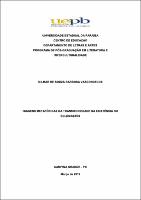| Compartilhamento |


|
Use este identificador para citar ou linkar para este item:
http://tede.bc.uepb.edu.br/jspui/handle/tede/2444Registro completo de metadados
| Campo DC | Valor | Idioma |
|---|---|---|
| dc.creator | Vasconcelos, Gilmar de Souza Barbosa | - |
| dc.contributor.advisor1 | Magalhães, Antônio Carlos de Melo | - |
| dc.date.accessioned | 2016-08-17T17:23:49Z | - |
| dc.date.issued | 2015-03-27 | - |
| dc.identifier.citation | Vasconcelos, Gilmar de Souza Barbosa. Imagens metafóricas da transitoriedade da existência no Eclesiastes. 2015. 104 p. Dissertação( Programa de Pós-Graduação em Literatura e Interculturalidade - PPGLI) - Universidade Estadual da Paraíba,Campina Grande. | por |
| dc.identifier.uri | http://tede.bc.uepb.edu.br/tede/jspui/handle/tede/2444 | - |
| dc.description.resumo | O objetivo desta dissertação é analisar as imagens metafóricas da morte no livro bíblico Eclesiastes, de autoria de Qohélet (ficcionalmente identificado como Salomão), buscando estabelecer uma compreensão hermenêutica que privilegie a poeticidade do texto, evidenciando, desta maneira, a relação entre teologia e literatura. Com esse objetivo, propõe-se a análise de algumas teses. No primeiro capítulo, acerca da Bíblia enquanto obra literária, o levantamento de dados histórico-literários estabeleceu-se através de autores como: Alter e Kermode (1997) e (2007); Auerbach (2013); Bloom (2009); Campos (1991) e (2000); Frye (2004) e (2013); Líndez (1999); Magalhães (2009); Ricoeur (1994, 2005, 2006, 2013) dentre outros. No segundo capítulo, prioriza-se o tema da existência e morte na Tanakh e articula-se o texto bíblico com as teses e reflexões de autores como: Gabel e Wheeler (2003); Gallazzi, et al, (1998); Wolff (2007) dentre outros. Por último, no terceiro capítulo, discorre-se sobre: Imagens metafóricas da morte. Neste ponto, observa-se que a obra (Eclesiastes) é marcada pelas reflexões existenciais feitas por Qohélet a partir de observações da transitoriedade da vida humana em seu cotidiano. O exame da vida e da existência, feito por Qohélet, o fez sentir a fragilidade de todo projeto humano. A tradição com sua doutrina retributiva não o convencem, pois a avaliou e constatou sua inveracidade. A única realidade que consegue enxergar é a de que ímpios e justos são tratados igualmente e que, todos, não passam de animais e como tais seres finitos, portanto, têm apenas um destino em comum: a morte. Afinal, o ser humano é “hevel” (vento), que é demonstrado através de imagens metafóricas, as quais percorrem, através de uma rede, toda a narrativa. | por |
| dc.description.abstract | The objective of this thesis is to analyze the metaphorical images of death in the Bible book Ecclesiastes, authorship of Qohélet (identified with fictitious name for Solomon), seeking to establish a common understanding hermeneutics that favors the poetry of the text, showing, in this way, the relationship between theology and literature. With this objective, it is proposed that the analysis of theses. In the first chapter, about the Bible as literary work, the survey data historical-literary established by authors such as: Alter and Kermode (1997) and (2007); Auerbach (2013); Bloom (2009); Campos (1991) and (2000); Frye (2004) and (2013); Líndez (1999); Magalhães (2009); Ricoeur (1994, 2005, 2006, 2013) among others. In the second chapter, prioritizes the theme of life and death in Tanakh and articulates the biblical text with the theses and reflections of authors such as: Gabel and Wheeler (2003); Gallazzi, et al, (1998); Wolff (2007) among others. Finally, in the third chapter, discourses on: Images of metaphorical death. At this point, it can be seen that the work (Ecclesiastes) is marked by existential reflections made by Qohélet from observations of the transience of human life in his daily life. The examination of the life and existence, done by Qohélet made him feel the fragility of all human project. The tradition with its retributive doctrine not convincing, because the evaluated and found its untruth. The only reality that can visualize is that wicked and righteous are treated equally and that all, not just animals and as such finite beings, therefore, has only one common target: death. After all, the human being is "hevel" (wind), which is demonstrated through metaphorical images, which follow through a network, the entire narrative. | eng |
| dc.description.provenance | Submitted by Deise Lorena Araújo (deiselorena@uepb.edu.br) on 2016-08-10T17:38:03Z No. of bitstreams: 1 PDFC-PDF - Gilmar de Souza Barbosa Vasconcelos.pdf: 21000356 bytes, checksum: a30e6ea61d150df0aa05bcc2bc3117b4 (MD5) | eng |
| dc.description.provenance | Approved for entry into archive by Luciana Medeiros (luciana@uepb.edu.br) on 2016-08-17T17:23:49Z (GMT) No. of bitstreams: 1 PDFC-PDF - Gilmar de Souza Barbosa Vasconcelos.pdf: 21000356 bytes, checksum: a30e6ea61d150df0aa05bcc2bc3117b4 (MD5) | eng |
| dc.description.provenance | Made available in DSpace on 2016-08-17T17:23:49Z (GMT). No. of bitstreams: 1 PDFC-PDF - Gilmar de Souza Barbosa Vasconcelos.pdf: 21000356 bytes, checksum: a30e6ea61d150df0aa05bcc2bc3117b4 (MD5) Previous issue date: 2015-03-27 | eng |
| dc.format | application/pdf | * |
| dc.thumbnail.url | http://tede.bc.uepb.edu.br/jspui/retrieve/5052/PDFC-PDF%20-%20Gilmar%20de%20Souza%20Barbosa%20Vasconcelos.pdf.jpg | * |
| dc.language | por | por |
| dc.publisher | Universidade Estadual da Paraíba | por |
| dc.publisher.department | Centro de Educação - CEDUC | por |
| dc.publisher.country | Brasil | por |
| dc.publisher.initials | UEPB | por |
| dc.publisher.program | Programa de Pós-Graduação em Literatura e Interculturalidade - PPGLI | por |
| dc.rights | Acesso Aberto | por |
| dc.subject | Análise Literária. Morte. Imagem Metafórica. Bíblia Sagrada - Literatura Teológica. Eclesiastes. | por |
| dc.subject.cnpq | CIENCIAS SOCIAIS APLICADAS | por |
| dc.title | Imagens metafóricas da transitoriedade da existência no Eclesiastes | por |
| dc.type | Dissertação | por |
| Aparece nas coleções: | PPGLI - Dissertações | |
Arquivos associados a este item:
| Arquivo | Descrição | Tamanho | Formato | |
|---|---|---|---|---|
| PDFC-PDF - Gilmar de Souza Barbosa Vasconcelos.pdf | 20.51 MB | Adobe PDF |  Baixar/Abrir Pré-Visualizar |
Os itens no repositório estão protegidos por copyright, com todos os direitos reservados, salvo quando é indicado o contrário.




